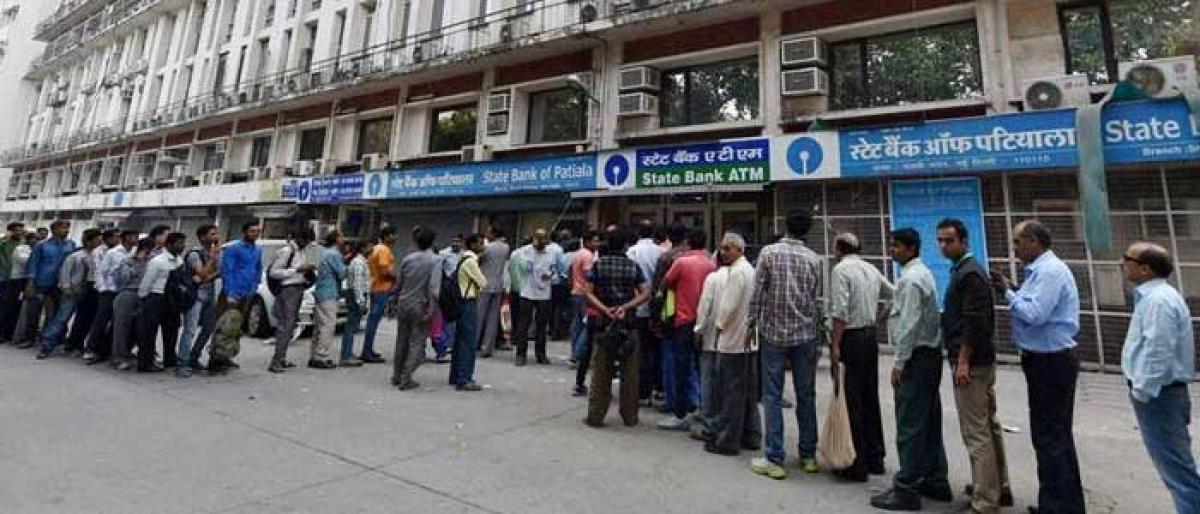Live
- Stimulating NREM sleep can boost cognitive function, memory
- EO releases TTD employees’ cricket team Jersey
- Priyanka Gandhi leads by 90,000 votes in Wayanad, Cong edges out BJP in Palakkad Assembly seat
- US CDC confirms H5N1 bird flu infection in child in California
- Dispose dump yard garbage in 3 months: TTD EO
- Gold rates in Vijayawada today surges, check the rates on 23 November, 2024
- Gold rates in Hyderabad today surges, check the rates on 23 November, 2024
- Punjab bypolls: Counting of votes begins for four Assembly seats
- Kakani lodges complaint against TDP
- Priyanka Gandhi leads in Wayanad, BJP ahead in Palakkad Assembly seat
Just In

The data released by the Reserve Bank of India (RBI) in its annual report raises some fundamental questions on the efficacy of government’s much-touted demonetisation measure.
The data released by the Reserve Bank of India (RBI) in its annual report raises some fundamental questions on the efficacy of government’s much-touted demonetisation measure.
The RBI report itself stated that more than 99 per cent of demonetised notes came back to the banking system. In fact, it may even cross 100 per cent if the currency coming from Bhutanese, Nepalese and cooperative banks is also included.
This leads us to the basic question – Does it mean that there was no black money held in cash? Certainly not. Black money is stashed in cash necessitating the demonetisation. People were subjected to unprecedented cash crunch as 86 per cent of currency was suddenly withdrawn from the economy. Still, people welcomed the move hoping that the black money would be unearthed and used for their welfare.
The government is yet to tell us how much black money was really found after demonetisation as the entire banned currency came back into the system.
Now, the Finance Minister invents another theory. Reacting to the controversy generated over the RBI data, Arun Jaitley said that all the banned notes that were deposited in the banks may not be accounted money. If so, whose accounts received unaccounted money. Why can’t the government take over such illegitimate financial assets?
In the absence of any such clarity, it only strengthens the feeling that the demonetisation resulting in the return of all the scrapped notes into the system has only facilitated the conversion of black money into white. Money laundering cannot be the objective of demonetisation.
Even during the period after demonetisation, media was agog with reports of how black money holders converted their illicit wealth into legitimate finances. In fact, the government spent more money on printing new currency and recalibrating ATMs than what it had really got.
There is no tangible evidence to substantiate the claims that demonetisation has curbed counterfeit currency, resulting in the reduction of terror-related incidents.
While the ill-effects of demonetisation are already felt and risks of such an unparalleled monetary contraction are evident, the gains of such a far-reaching economic policy prescription are hazy.
Government might have won the perception battle due to the prevalence of Robin Hood syndrome in society. But, the economic battle should not be lost in polemics.
Meanwhile, the monetary contraction due to demonetisation led to artificial recession with especially informal sector getting strangulated. The growth got decelerated. Livelihoods were eroded.
The government talks about the gains like increased tax compliance, greater digitalisation etc. But, they were the secondary objectives while curbing black money was the paramount.
The government cannot escape from answering the questions over the extent of black money recovered after demonetisation by referring to other perceived gains.
The political mandate the ruling party received in the elections held subsequent to demonetisation cannot justify the economic rationale of demonetisation. Any such reading is erroneous and self-defeating.

© 2024 Hyderabad Media House Limited/The Hans India. All rights reserved. Powered by hocalwire.com







